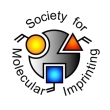Authors: Zarejousheghani M, Schrader S, M+Āder M, Lorenz P, Borsdorf H
Article Title: Ion-exchange molecularly imprinted polymer for the extraction of negatively-charged acesulfame from wastewater samples.
Publication date: 2015
Journal: Journal of Chromatography A
DOI: 10.1016/j.chroma.2015.07.107
Alternative URL: http://www.sciencedirect.com/science/article/pii/S0021967315011152
Abstract: Acesulfame is a known indicator that is used to identify the introduction of domestic wastewater into water systems. It is negatively charged and highly water-soluble at environmental pH values. In this study, a molecularly imprinted polymer (MIP) was synthesized for negatively-charged acesulfame and successfully applied for the selective solid phase extraction (SPE) of acesulfame from influent and effluent wastewater samples. (Vinylbenzyl)trimethylammonium chloride (VBTA) was used as a novel phase transfer reagent, which enhanced the solubility of negatively charged acesulfame in the organic solvent (porogen) and served as a functional monomer in MIP synthesis. Different molecularly imprinted polymers were synthesized to optimize the extraction capability of acesulfame. The different materials were evaluated using equilibrium rebinding experiments, selectivity experiments and scanning electron microscopy (SEM). The most efficient MIP was used in a molecularly imprinted-solid phase extraction (MISPE) protocol to extract acesulfame from wastewater samples. Using high-performance liquid chromatography-tandem mass spectrometry (HPLC-MS-MS) analysis, detection and quantification limits were achieved at 0.12 μg L-1 and 0.35 μg L-1, respectively. Certain cross selectivity for the chemical compounds containing negatively-charged sulfonamide functional group was observed during selectivity experiments
Author keywords: Acesulfame, (vinylbenzyl)trimethylammonium chloride phase transfer, Molecularly imprinted polymer, ammonium salt, Wastewater



Join the Society for Molecular Imprinting

New items RSS feed
Sign-up for e-mail updates:
Choose between receiving an occasional newsletter or more frequent e-mail alerts.
Click here to go to the sign-up page.
Is your name elemental or peptidic? Enter your name and find out by clicking either of the buttons below!
Other products you may like:
 MIPdatabase
MIPdatabase









